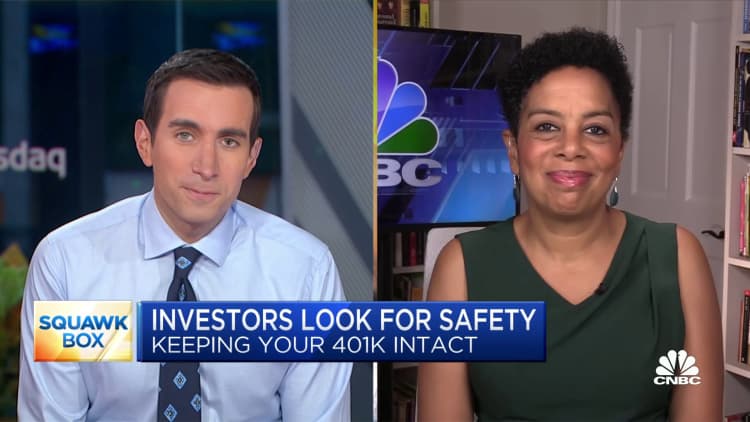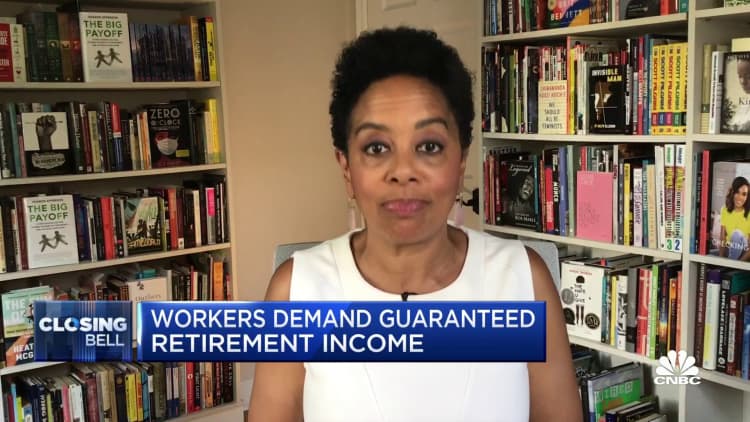
‘Ugly times’ are pushing record annuity sales. Here's what you need to know before you buy
Consumers are funneling money into annuities as the stock market tanks and higher interest rates raise payouts for buyers.
Annuity sales in the third quarter of 2022 approached $80 billion, just edging out the $79.4 billion record set in Q2, according to estimates published by Limra, an insurance industry trade group.
Consumers are on pace to buy almost $300 billion of annuities in 2022, which would handily beat the $265 billion purchased in 2008, the current annual record, said Todd Giesing, assistant vice president of Limra Annuity Research.
As during the 2008 financial crisis, purchasing decisions seem largely guided by fear of volatility in the stock market and the possibility of recession.
The S&P 500 stock index firmly entered a bear market in June, and is still down nearly 19% in 2022 as of Wednesday afternoon. An investor holding U.S. bonds, which typically act as a ballast when stocks fall, has lost almost 16% in the past year.
Meanwhile, the Federal Reserve is trying to cool the economy by increasing borrowing costs, aiming to tame high inflation; some economists think the central bank may go too far and tip the U.S. into a downturn.
"In ugly times, people get concerned about safety," said Lee Baker, a certified financial planner and founder of Apex Financial Services, based in Atlanta. Baker is also a member of CNBC's Advisor Council.
But annuities may not make sense for everyone, according to financial advisors.
More from Personal Finance:
Here are tips for buying a home in a cooling market
New York City helps kick off 'wave of pay transparency legislation'
Consumer watchdog is upping efforts to crack down on 'junk fees' at banks
Buyers are looking for 'downside protection'
There are many types of annuities. They generally serve one of two functions: as an investment or as a quasi-pension plan offering income for life in retirement.
Insurance companies, which issue annuities, offer buyers guarantees that hedge risk like market volatility or the danger of outliving savings in old age.
All annuity categories are benefiting from higher interest rates, which generally translate to insurers paying a better return on investment.
But lately, consumers have been pumping record money into two categories: fixed-rate deferred annuities and indexed annuities, according to Limra data.

Fixed-rate deferred annuities work like a certificate of deposit offered by a bank. Insurers guarantee a rate of return over a set period, maybe three or five years. At the end of the term, buyers can get their money back, roll it into another annuity or convert their money into an income stream.
Indexed annuities hedge against downside risk. They are tied to a market index like the S&P 500; insurers cap earnings to the upside when the market does well but put a floor on losses if it tanks.
The average age of indexed-annuity buyers is about 63 years old — suggesting many are worried about the prospect of losing money as they approach retirement age, Giesing said.
"Anything that's protection-based and has some downside protection is doing very well," Giesing said of sales.
Meanwhile, consumers are shying away from variable annuities, the performance of which is generally directly tied to the stock market. Sales are on pace for their lowest year since 1995, according to Limra.
How to know if an annuity makes sense for you
Financial advisors often recommend using a different flavor of annuity when building financial plans: a single-premium immediate annuity or deferred-income annuity.
These are for retirees seeking a guaranteed, pension-like income each month for life. Payouts from immediate annuities start right away, while those from deferred-income annuities starts later, perhaps in a retiree's 70s or 80s.
These payments, coupled with other guaranteed sources of income like Social Security, help ensure a retiree has cash to cover necessities (a mortgage, utilities, food, etc.) if they live a long time and their investments are tapped out or dwindling.

"Am I worried about the client running out of money? If yes, that's when I think about an annuity," said Carolyn McClanahan, a certified financial planner and founder of Life Planning Partners, based in Jacksonville, Florida.
McClanahan, a member of CNBC's Advisor Council, doesn't use single-premium immediate annuities or deferred-income annuities with clients who have more than enough money to live comfortably in retirement. Annuities become more of a preference for those in the middle, who are likely but not necessarily going to have enough; for them, it's more of an emotional calculus: Will having more guaranteed income offer peace of mind?
'A lot of people don't understand the limitations'
Of course, different categories of annuities come with tradeoffs.
Single-premium immediate annuities and deferred-income annuities are relatively simple to understand compared with other categories, advisors said. The buyer hands over a lump sum to the insurer, which then guarantees a certain monthly payment to the buyer starting now or later.
They also offer retirees the biggest bang for their buck relative to other types, according to advisors and insurance experts.
That's because they don't come with bells and whistles that cost buyers money. For example, consumers can buy variable and indexed annuities with certain features — known as "guaranteed living benefits" — that let buyers opt for a lifetime income stream or for liquidity if they need money or no longer want their investment. Those benefit features also generally come with restrictions and other fine print that may be difficult for consumers to understand, advisors said.
"The fancier the annuity, the more the underlying fees are," McClanahan said. "And a lot of people don't understand the limitations. It's important to know what you're buying."
By contrast, consumers can't get back principal when they buy single-premium immediate annuities or deferred-income annuities. This is one likely reason consumers don't buy them as readily, despite their income efficiency, Giesing said.
The fancier the annuity, the more the underlying fees are. And a lot of people don't understand the limitations. It's important to know what you're buying.Carolyn McClanahancertified financial planner and founder of Life Planning Partners
Quarterly single-premium immediate annuity sales have hovered around $2.5 billion, and consumers buy about $500 million to $600 million of deferred-income annuities, Giesing said — about a tenth and a fiftieth, respectively, of the nearly $30 billion of fixed-deferred-annuity sales in the third quarter.
From a behavioral standpoint, protection-focused annuities may make sense for someone five to 10 years away from retirement who can't stomach investment volatility and is willing to pay a slightly higher cost for stability, Baker said.
But Baker cautioned that value proposition likely doesn't make sense for investors any more. It would effectively lock in big stock and bond losses, and then cap gains to the upside for the term of the insurance contract, he said. Investors can now get a return over 4% on safe-haven assets like shorter-term U.S. Treasury bonds (a 3-month, 1-year and 3-year, for example) if they hold those bonds to maturity.






